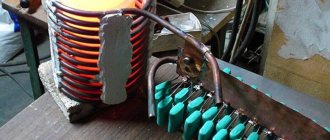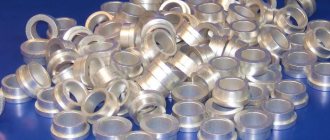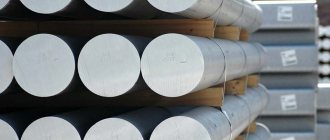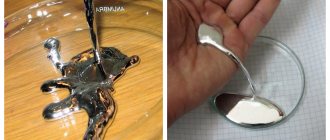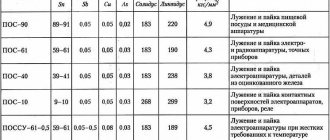A metal such as aluminum is very common in the world. A considerable amount of it is contained in the human body, and there is even more of it in the surrounding world. Among the materials from which houses are built, as well as in the design of any car, there is a certain amount of aluminum.
Furniture parts are often made from this substance. And if suddenly one of these breaks, then you can either purchase a new product in the appropriate store, or repair the product yourself. In the latter case, you will have to melt the metal at home, and for this you already need to know about some of the properties of this metal.
To manufacture any aluminum structure, it is not at all necessary to study in detail all the characteristics of the substance, but you should pay attention to the main points, including knowing at what temperature aluminum melts.
Composition and structure of aluminum
Aluminum is the most common metal in the earth's crust.
It is classified as a light metal. It has low density and mass. In addition, it has a fairly low melting point. At the same time, it has high ductility and shows good thermal and electrical conductivity characteristics. Aluminum crystal lattice
Aluminum structure
The tensile strength of pure aluminum is only 90 MPa. But, if you add some substances to the melt, for example, copper and a number of others, then the tensile strength increases sharply to 700 MPa. The same result can be achieved using heat treatment.
Aluminum, which has extremely high purity - 99.99%, is produced for use in laboratory purposes. For industrial applications, commercially pure aluminum is used. When producing aluminum alloys, additives such as iron and silicon are used. They do not dissolve in the aluminum melt, and the additive reduces the ductility of the base material, but at the same time increases its strength.
Appearance of a simple substance
The structure of this metal consists of simple cells consisting of four atoms. This structure is called face-centric.
Calculations show that the density of pure metal is 2.7 kg per cubic meter.
How to make a casting mold
Creating a simple solder material does not require making a special mold. You can pour metal onto a steel sheet.
The following materials are used to create the form:
- Gypsum.
- Sand.
- Clay.
- Coal ash.
- Liquid glass.
The alloy is poured into the mold in different ways:
- Open.
- Closed.
The open method is simple. The molten metal is poured into a regular container, tin can, cup, etc. When the substance solidifies, the blank is removed from the container. If the shape of the metal object is not important, you can leave the aluminum on a durable surface.
Complex casting requires the product to comply with the specified parameters; for this, molding elements are used. Silica is a common substance that is often used in open pour applications. The product consists of two containers into which earth is poured and compacted. The silica elements are compressed and a casting pattern is placed between them. This way you can get an accurate print of the required part. The model is removed and hot aluminum is placed into the mold. For the closed casting method, river sand mixed with liquid glass is used.
Plaster can be used for one-time casting. Models are made from paraffin or foam plastic. The use of such materials requires working in an open space with good air access. The foam is not removed from solid plaster, it is filled with hot aluminum. The combustion products of this substance are harmful to health.
Melting aluminum
Influence of alloying elements and impurities
Adding other elements to aluminum, including alloying ones, reduces its melting point, or more precisely, the beginning of its melting. Thus, for some cast aluminum alloys with a high content of silicon and magnesium, the melting point decreases to almost 500 °C. In general, the concept of “melting point” applies only to pure metals and other crystalline substances. Alloys do not have a specific melting point: the process of their melting (and solidification) occurs in a certain temperature range.
Figure 4 - Change in the specific volume of pure metal (aluminum) and the alloy of this metal (aluminum alloy) [4]
Melting temperature ranges
The table below presents the liquidus and solidus temperatures of some commercial wrought alloys. It must be borne in mind that the concepts of solidus and liquidus temperatures are defined for equilibrium transformations of the liquid phase into the solid phase and vice versa, that is, for infinite duration of the processes. In practice, corrections must be made taking into account the rate of heating or cooling.
Melting silumin
Not all alloys have a range between solidus and liquidus temperatures. Such alloys are called eutectic. For example, in an aluminum alloy containing 12.5% silicon, the liquidus and solidus points are reduced to a point: this alloy, like pure metals, has not an interval, but a melting point. This point and temperature is called eutectic. This alloy belongs to the famous cast aluminum-silicon alloys - silumins with a narrow solidus-liquidus interval, which gives them the best casting properties.
In the Al-Si binary alloy, the solidus temperature is constant and amounts to 577 °C. As the silicon content increases, the liquidus temperature decreases from a maximum value for pure aluminum of 660 °C to coincide with the solidus temperature of 577 °C at a silicon content of 12.6%.
Among other alloying elements of aluminum, magnesium lowers the melting point the most: the eutectic temperature of 450 ° C is achieved with a magnesium content of 18.9%. Copper gives a eutectic temperature of 548 °C, and manganese - only 658 °C! Most alloys are not double, but triple and even quadruple. Therefore, with the combined influence of several alloying elements, the solidus temperature—the beginning of melting or the end of solidification—can be even lower.
Production
aluminum production
One beautiful, but probably implausible legend from “Historia naturalis“
says that one day a jeweler came to the Roman emperor Tiberius (42 BC - 37 AD) with a metal, unbreakable dinner plate, allegedly made from alumina - Al2O3. The plate was very light and shone like silver. By all indications, it should be aluminum. At the same time, the jeweler claimed that only he and the gods knew how to obtain this metal from clay. Tiberius, fearing that metal from easily accessible clay could devalue gold and silver, ordered, just in case, to cut off the man’s head. Obviously, this legend is very doubtful, since native aluminum does not occur in nature due to its high activity, and during the Roman Empire there could not have been technical means that would have made it possible to extract aluminum from alumina.
Only almost 2000 years later - in 1825, the Danish physicist Hans Christian Oersted obtained several milligrams of metallic aluminum, and in 1827 Friedrich Wöhler was able to isolate grains of aluminum, which, however, were immediately covered in air with a thin film of aluminum oxide.
Until the end of the 19th century, aluminum was not produced on an industrial scale.
Only in 1854, Henri Saint-Clair Deville invented the first method of industrial production of aluminum, based on the displacement of aluminum by metallic sodium from double sodium chloride and aluminum NaCl AlCl3. In 1855, the first metal ingot weighing 6-8 kg was obtained. Over 36 years of use, from 1855 to 1890, 200 tons of aluminum metal were produced using the Saint-Clair Deville method. In 1856, he also obtained aluminum by electrolysis of a molten sodium-aluminum chloride.
In 1885, based on the technology proposed by Russian scientist Nikolai Beketov, an aluminum production plant was built in the German city of Gmelingem. Beketov’s technology was not much different from Deville’s method, but it was simpler and involved the interaction between cryolite (Na3AlF6) and magnesium. In five years, this plant produced about 58 tons of aluminum - more than a quarter of all world production of the metal by chemical means in the period from 1854 to 1890.
The method, invented almost simultaneously by Charles Hall in France and Paul Héroux in the USA in 1886 and based on the production of aluminum by electrolysis of alumina dissolved in molten cryolite, laid the foundation for the modern method of aluminum production. Since then, due to improvements in electrical engineering, aluminum production has improved. A notable contribution to the development of alumina production was made by Russian scientists K. I. Bayer, D. A. Penyakov, A. N. Kuznetsov, E. I. Zhukovsky, A. A. Yakovkin and others.
The first aluminum smelter in Russia was built in 1932 in Volkhov. The metallurgical industry of the USSR in 1939 produced 47.7 thousand tons of aluminum, another 2.2 thousand tons were imported.
World War II greatly stimulated aluminum production. Thus, in 1939, its global production, excluding the USSR, was 620 thousand tons, but by 1943 it had grown to 1.9 million tons.
By 1956, the world produced 3.4 million tons of primary aluminum, in 1965 - 5.4 million tons, in 1980 - 16.1 million tons, in 1990 - 18 million tons.
In 2007, the world produced 38 million tons of primary aluminum, and in 2008 - 39.7 million tons. The leaders in production were: China (produced 12.60 million tons in 2007, and 13.50 million tons in 2008), Russia (3.96/4.20), Canada (3.09/3.10), USA (2.55/2.64), Australia (1.96/1.96), Brazil (1.66/ 1.66), India (1.22/1.30), Norway (1.30/1.10), UAE (0.89/0.92), Bahrain (0.87/0.87), South Africa (0.90/0.85), Iceland (0.40/0.79), Germany (0.55/0.59), Venezuela (0.61/0.55), Mozambique (0.56/055 ), Tajikistan (0.42/0.42).
In Russia, the de facto monopolist in aluminum production is Russian Aluminum OJSC, which accounts for about 13% of the world aluminum market and 16% of alumina.
The world's reserves of bauxite are practically limitless, that is, they are incommensurate with the dynamics of demand. Existing facilities can produce up to 44.3 million tons of primary aluminum per year. It should also be taken into account that in the future some of the applications of aluminum may be reoriented to the use of, for example, composite materials.
Properties and characteristics
Aluminum is a metal with a silvery-white surface. As already noted, its density is 2.7 kg/m3. The temperature is 660°C.
Its electrical conductivity is equal to 65% of copper and its alloys. Aluminum and most of its alloys are resistant to corrosion. This is due to the fact that an oxide film forms on its surface, which protects the base material from exposure to atmospheric air.
In the untreated state, its strength is 60 MPa, but after adding certain additives it increases to 700 MPa. The hardness in this state reaches 250 HB.
Aluminum can be easily processed under pressure. To remove work hardening and restore ductility after processing, aluminum parts are annealed, and the temperature should be within 350°C.
Toxicity
It has a slight toxic effect, but many water-soluble inorganic aluminum compounds remain in a dissolved state for a long time and can have a harmful effect on humans and warm-blooded animals through drinking water. The most toxic are chlorides, nitrates, acetates, sulfates, etc. For humans, the following doses of aluminum compounds (mg/kg body weight) have a toxic effect when ingested: aluminum acetate - 0.2-0.4; aluminum hydroxide - 3.7-7.3; aluminum alum - 2.9. Primarily affects the nervous system (accumulates in nervous tissue, leading to severe disorders of the central nervous system). However, the neurotoxicity of aluminum has been studied since the mid-1960s, since the accumulation of the metal in the human body is prevented by its elimination mechanism. Under normal conditions, up to 15 mg of the element per day can be excreted in the urine. Accordingly, the greatest negative effect is observed in people with impaired renal excretory function.
The standard for aluminum content in drinking water is 0.2 mg/l. In this case, this MPC can be increased to 0.5 mg/l by the chief state sanitary doctor for the relevant territory for a specific water supply system.
Melting point of aluminum
The production of aluminum melt, like many other materials, occurs after thermal energy has been supplied to the original metal. It can be supplied either directly into it or from outside.
The melting point of aluminum directly depends on the level of its purity:
- Ultra-pure aluminum melts at a temperature of 660.3°C.
- With an aluminum content of 99.5%, the melting point is 657°C.
- With a content of this metal of 99%, the melt can be obtained at 643°C.
Aluminum melt
Aluminum production process
An aluminum alloy can contain various substances, including alloying ones. Their presence leads to a decrease in the melting point. For example, if there is a large amount of silicon, the temperature can drop to 500°C. In fact, the concept of melting point applies to pure metals. Alloys do not have any constant melting point. This process occurs within a certain heating range.
In materials science there is a concept - solidus and liquidus temperatures.
The first temperature indicates the point at which the melting of aluminum begins, and the second shows at what temperature the alloy will finally melt. In the interval between them, the alloy will be in a mushy state.
Melting point of pure aluminum
Melting of aluminum , like other substances, occurs when thermal energy is supplied to it, from the outside or directly into its volume, as happens, for example, with induction heating.
The melting point of aluminum depends on its purity:
- Melting point of ultra-pure aluminum 99.996%: 660.37 °C.
- With an aluminum content of 99.5%, melting begins at 657 °C.
- With an aluminum content of 99.0%, melting begins at 643 °C.
General information about the process
In the solid state, the crystal lattice of a metal consists of grains that are spatially oriented in an arbitrary manner (such structures are called polycrystalline).
During the melting process, the volume of the metal increases. In chemically pure ones, it occurs quickly and at certain temperatures. Example. Actual Al melting temperature (t):
- ultrapure, with a percentage of Al 99.996%, equals 660.37 ° C;
- when the proportion of pure metal decreases to 99.5, t=657°C;
- at 99.0%, t=643°C.
A sharp increase in volume occurs under the influence of a certain heat, which initiates melting. This quantity is called latent heat.
The latter contributes to the fact that the original crystalline structure of the material loses order and density. The process is reversible (cooling/heating).
Decrease temperature
Before you start melting metal, you can perform certain operations that will reduce the melting temperature. For example, sometimes aluminum powder is melted. In a powdered state, the metal begins to melt somewhat faster. But with such processing, there is a real danger that when interacting with oxygen contained in the atmosphere, aluminum powder will begin to oxidize with a large release of heat and the formation of metal oxides; this process occurs at a temperature of 2300 degrees. The main thing is to prevent contact between the melt and water at this moment of melting. This will cause an explosion.
Melting point of metals
Metals and non-metals
Any piece of metal, such as aluminum, contains millions of individual crystals called grains. Each grain has its own unique orientation of the atomic lattice, but collectively the grains are oriented randomly within that piece. This structure is called polycrystalline.
Amorphous materials such as glass differ from crystalline materials such as aluminum in two important ways that are related to each other:
- lack of long-range order in molecular structure
- differences in the nature of melting and thermal expansion.
The difference in molecular structure can be seen in Figure 1. The close-packed and ordered crystal structure is shown on the left. An amorphous material is shown on the right: a less dense structure with a random arrangement of atoms.
Figure 1 – Structure of crystalline (a) and amorphous (b) materials. Crystalline structure: ordered, repeating and dense, amorphous structure - more loosely packed with a random arrangement of atoms.
Melting metals
This difference in structure manifests itself during the melting of metals, including the melting of aluminum of various purities and its alloys. Less densely packed atoms produce an increase in volume (decrease in density) compared to the same metal in a solid crystalline state.
Application of metal in industrial production
Under natural conditions, aluminum tends to form a thin oxide film, which prevents reactions with water and nitric acid (without heating). When the film is destroyed as a result of contact with alkalis, the chemical element acts as a reducing agent.
In order to prevent the formation of an oxide film, other metals (gallium, tin, indium) are added to the alloy. The metal is practically not subject to corrosion processes. It is a popular material in various industries.
Aluminum and its alloys are in great demand in various spheres of human life.
- Aluminum is considered a popular material for making tableware and the main raw material for the aviation and space industries. The excellent electrical conductivity of the metal allows it to be used for sputtering conductors in microelectronics.
- The property of aluminum and its alloys to become brittle at low temperatures allows it to be used in cryogenic technology. Reflectivity and low cost, ease of vacuum deposition make aluminum an indispensable material for the manufacture of mirrors.
- The application of metal to the surface of parts of turbines and oil platforms makes steel alloys resistant to corrosion. Metal sulfide is used to produce hydrogen sulfide, and pure aluminum is used as a reducing agent for rare alloys from oxides.
- The chemical element is used as a component of compounds, for example, in aluminum bronzes and magnesium alloys. Along with other materials, it is used for the manufacture of spirals in electric heating devices. Metal compounds are widely used in glass making.
- Currently, pure aluminum is rarely used as a material for jewelry, but its alloy with gold, which has a special shine and sparkle, is gaining popularity. In Japan, metal is used instead of silver to make jewelry.
- Aluminum is registered as an additive in the food industry. Aluminum beer cans have been a popular beverage packaging since the 1960s. The technological line provides for the production of containers of 0.33 and 0.5 liters. The packaging has the same diameter and differs only in height.
- The main advantage of packaging over glass is the possibility of recycling the material.
- Cans for beer (carbonated drinks) can withstand pressure up to 6 atmospheres, have a dome-shaped, thick bottom and thin walls. Features of the manufacturing technology by drawing ensure the structural strength and reliable performance properties of the container.
Melting process at home
The relatively low melting point of aluminum allows this operation to be carried out at home. It should be noted right away that using a powdered mixture as a raw material in a home workshop is too dangerous. Therefore, either ingots or cut wire are used as raw materials. If there are no special quality requirements for the future product, then anything made from this metal can be used for melting.
Melting aluminum in a homemade forge
In this case, it is not particularly important whether the raw materials are coated with paint or not. When aluminum melts, all foreign substances will simply burn out and be removed along with the slag.
To obtain a high-quality melting result, it is necessary to use materials called fluxes. They are designed to solve the problem of binding and removing foreign impurities and contaminants from the melt.
Means of protection
A home craftsman who decides to melt aluminum at home should be aware that this is a rather dangerous process. And therefore it is impossible to do without the use of protective equipment. In particular, gloves, an apron, and goggles should be used. The fact is that the melt temperature is within 600 degrees. Therefore, it makes sense to use the protective equipment that welders use.
Using protective equipment when melting aluminum
By the way, when melting aluminum and using cleaning chemicals, it is necessary to protect the respiratory system from combustion products.
Receipt
The modern production method was developed independently by the American Charles Hall and the Frenchman Paul Héroult. It consists of dissolving aluminum oxide Al2O3 in a melt of cryolite Na3AlF6, followed by electrolysis using graphite electrodes. This production method requires a lot of electricity, and therefore became popular only in the 20th century.
To produce 1 ton of crude aluminum, 1.920 tons of alumina, 0.065 tons of cryolite, 0.035 tons of aluminum fluoride, 0.600 tons of anode mass and 17 thousand kWh of DC electricity are required.

